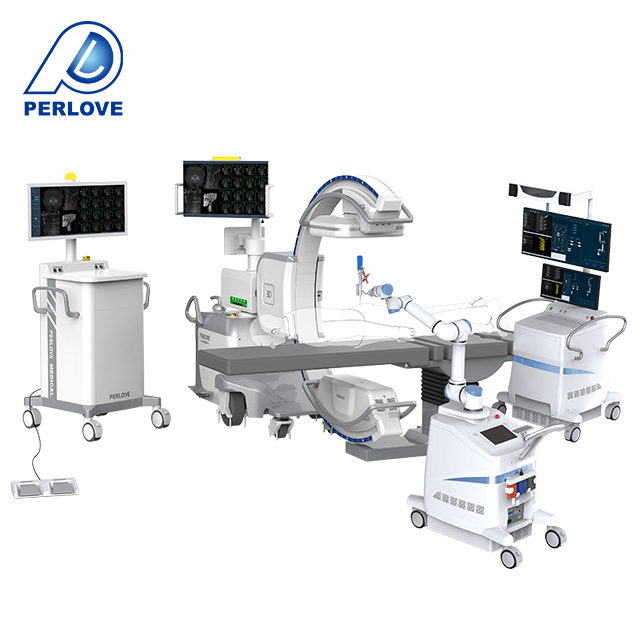Is the battery thermal management system for electric vehicles simple? SES
Power analyzes the thermal management of lithium batteries for you
As a manufacturer with nearly 20 years of experience in customizing
lithium-ion batteries, SES Power focuses on the integration of lithium-ion
battery energy storage systems, such as fully intelligent lead-acid replacement
products with Bluetooth or RS485 communication ( Lithium iron phosphate
12V100Ah, 12V200Ah), high current (2000A) starting lithium battery, UPS high
voltage lithium battery system (up to 860V), 3Kw~20Kw off-grid, grid-connected,
island-type lithium battery energy storage system, base station communication
backup battery system ( Standard 19 inches), a full set of photovoltaic energy
storage components, etc. But we also have a lot of products that are used in
power equipment, which are close to the requirements of electric vehicles, such
as lithium batteries for large electric forklifts, electric ships, etc., and the
knowledge of lithium batteries is the same, so we have the same knowledge about
lithium battery systems for electric vehicles. Not unfamiliar.
Thermal management is an important part of electric vehicles, which is
related to the health of the energy system of lithium batteries. SES Power will
give you an in-depth analysis of the battery thermal management system of
electric vehicles.
A: What is the function of battery thermal management?
The most suitable working temperature of lithium battery is between
10-30°C. And the working environment of the car is very broad, -20-+50°C is very
common, so what should we do? Then there are only 3 functions of thermal
management:
The first function is cooling. When the temperature is too high, the
capacity decay of the battery will be accelerated, and the risk of thermal
runaway will increase. Therefore, when the temperature is too high, heat
dissipation is required.
The second function is heating: when the temperature is too low, the
capacity of the battery will also be attenuated, the performance will be
degraded, and even there will be potential safety hazards during charging (the
internal short circuit caused by the precipitation of lithium has the risk of
thermal runaway). Therefore, when the temperature is too low, heating (or
insulation) is required.
The third function is to maintain temperature consistency: the purpose is
to keep the temperature consistent for each battery in different working
environments. Simply put, the power battery needs to reduce the temperature
difference in space as much as possible.
B: Is it important to maintain temperature consistency?
For batteries, maintaining a consistent temperature is just as important as
the first two functions and stems from three things:
The first is the barrel effect: the performance and reliability of a
battery system depend on the weakest cell, and the safety of the system depends
on the most unstable cell.
To give a practical example in engineering, the following figure is the
curve of the maximum discharge current of a certain type of ternary lithium
battery with temperature. It can be seen that the performance of the battery has
a very large relationship with the temperature. Assuming that the temperature of
most cells is 20 degrees, and the temperature of battery B is only 10 degrees
because of the slow heating, the entire battery pack must accommodate the B
cell, the discharge current is forced to drop from 140A to 100A, and the
performance drops by one-third.

The second is to reduce secondary inconsistencies: differences in operating
temperature are the main cause of secondary inconsistencies. The inherent
individual differences of single cells when they leave the factory are called
primary inconsistencies, and the differences between single cells that gradually
increase during use are called secondary inconsistencies.
The primary inconsistency mainly reflects the manufacturing and testing
level of the cell manufacturer. Its causes are very complex, involving factors
such as material system, variety, manufacturing process, and on-site
control.
The secondary inconsistency mainly reflects the system integration level of
the pack factory or integrator, especially the thermal management design level.
That is to say, no matter how good the battery cells are, if the system
integration capability of the pack factory is poor, the differences between the
cells will gradually expand during use, which will bring performance degradation
and safety risks.
The third is to avoid the chain reaction: the expansion of battery
differences is a gradual process, perhaps only the case where the capacity is 5%
smaller and the internal resistance is 10% larger; but the thermal runaway of
the battery pack caused by the weakest link is a sudden process ,Why is this so?
The reason is the chain reaction.
The side reaction of the battery is usually exothermic. If the heat
dissipation conditions are not good, the thermal runaway of the single battery
will release a lot of heat. If the thermal insulation/heat dissipation
conditions between the single cells are not good, the heat may cause thermal
runaway of adjacent cells, which in turn causes thermal runaway of the entire
module (module) or even the entire battery pack (Pack).
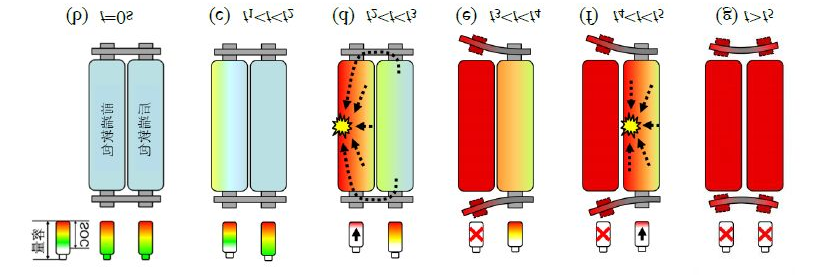
(The thermal runaway of the single battery causes the thermal runaway of
the related monomer)
It can be seen that, as a representative function of battery thermal
management, temperature consistency can be used as one of the core indicators to
measure the level of battery management technology.
C: How difficult is it to ensure temperature consistency?
Reducing the temperature difference between single cells mainly depends on
the design of the heat dissipation runner. This is a very challenging content,
and there are different solutions in the industry.
Consider the simplest one-dimensional design first. Figure (a) is the
simplest design. The cooling carrier (air-cooled as air, liquid-cooled as water
or coolant) flows from left to right, which brings a problem: the right side The
temperature of the coolant is higher and the heat dissipation effect is poor,
and the temperature of the rightmost single battery will be significantly higher
than the leftmost one.
Figure (b) has made some improvements. The wedge-shaped flow channel
accelerates the flow rate of the cooling carrier on the right side, which
offsets the factor of higher coolant temperature, so that the effect is better
than that in Figure (a). The problem is that the inside of the battery pack is
very limited, and the angle of the wedge cannot be designed to be very large, so
the effect of this design will not be much better than Figure (a).
Figure (c) is designed with a convection flow channel, where the coolant
periodically changes its flow direction, thereby attenuating the temperature
difference by half. However, this solution also has a price. If it is
air-cooled, it can be achieved by using fans alternately blowing air, but if it
is liquid-cooled, it is difficult to achieve in engineering.
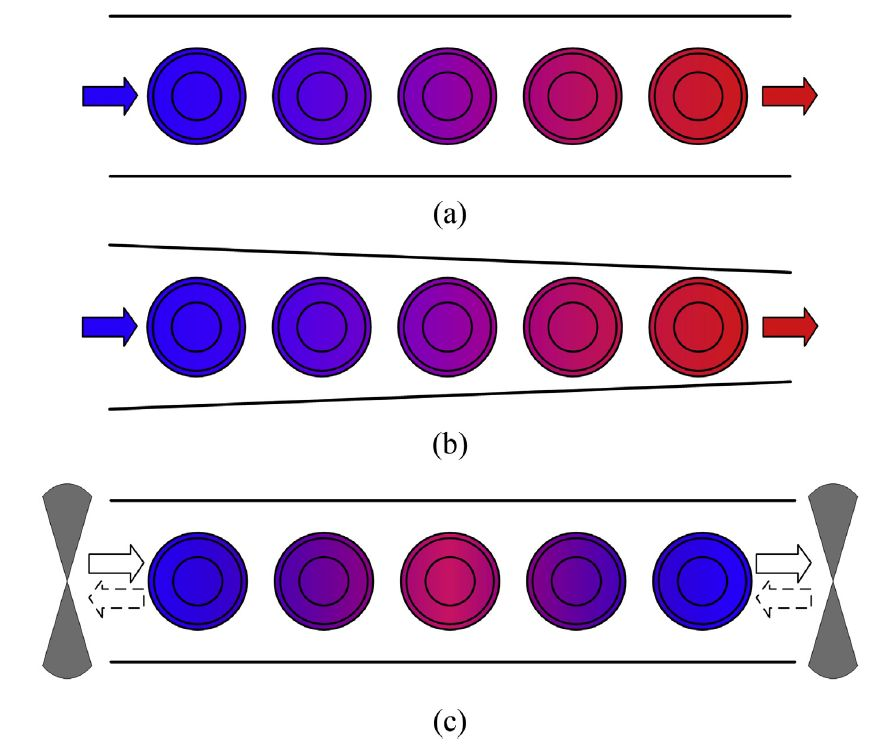
One-dimensional design does not seem to be difficult to understand, so
let's look at the two-dimensional situation: the left side is aligned and the
right side is staggered.
So can we intuitively answer the following questions?
-Which one has higher temperature rise during discharge?
-Which temperature difference is greater during discharge?
-During the discharge process, are the downstream single cells higher in
temperature?

In fact, this is difficult to answer intuitively, and you must resort to
computational fluid dynamics and heat transfer (simulating with a bunch of
partial differential equations, SES Power engineers will also have a
headache).

Let's look directly at the conclusions of the relevant data:
In the case of the same flow, the heat dissipation of the staggered
arrangement is better and the temperature rise is lower; but the energy
consumption of driving the cooling carrier is greatly increased. (Aligned
arrangement can only blow the side, and staggered discharge can blow the front,
so the heat dissipation effect is better, but the flow resistance is
greater)
As the radial distance increases, the temperature rise of the aligned
arrangement decreases, while the temperature rise of the staggered arrangement
is the opposite. This is counterintuitive.
The temperature inconsistencies of the two arrangements are similar, but
the temperature distribution laws are quite different. In the staggered
arrangement, the temperature rise of the midstream single cell is the smallest,
and the temperature rise of the upstream and downstream single cells is larger,
which is counterintuitive.
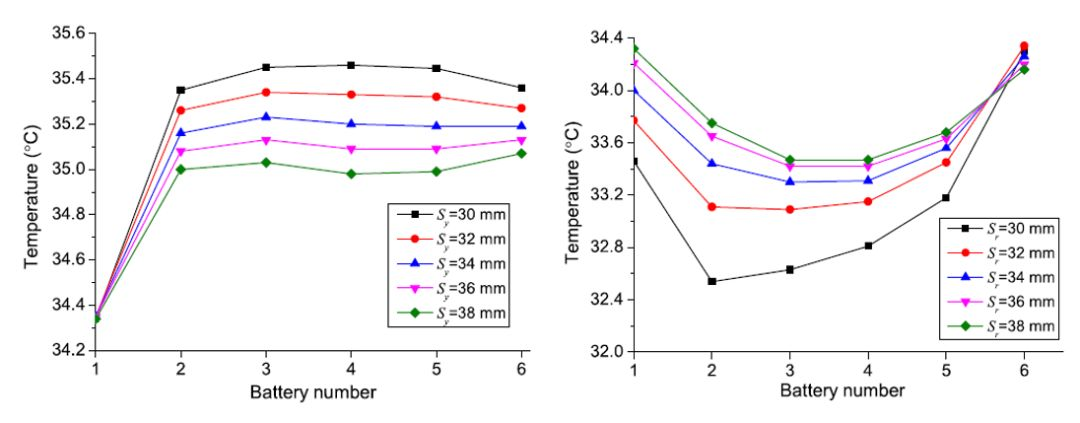
The actual situation is actually three-dimensional, which is much more
complicated than the two-dimensional situation, because it is necessary to
consider the influence of the layout of the whole vehicle, the shape of the
cells after grouping may not be a complete cuboid, each car will have different
encounters, etc. These situations will bring greater challenges to cell thermal
management.
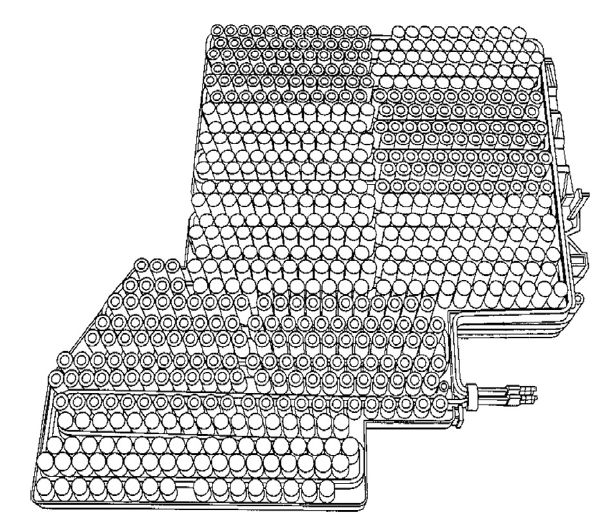
SES Power has analyzed it for you. I believe you can understand the
difficulty of battery thermal management. Some engineers even start to be glad
that they are not in this position, because it is really difficult!
D: What is the difference between the thermal management of cylindrical
lithium batteries and square lithium batteries?
Generally speaking, a qualified battery pack should control the temperature
difference within ±5°C. If it can be achieved within ±2°C, it can be called
excellent. Those who can achieve this standard include the traditional car giant
General Motors and Tesla, the leader of the new car-making forces.
d1: 18650 cylindrical battery used by Tesla
The contact surface is relatively small and the monomer capacity is low.
With a large number of used, these factors increase the difficulty of
controlling the battery temperature to be consistent. Therefore, Tesla has put a
lot of thought into thermal management design, and some design ideas can be seen
from the published patents.
The first is that Tesla uses serpentine heat sinks. In this way, the
curvature of each heat sink is consistent with the cylindrical shape, which can
achieve a contact area of more than half a circle, which can promote heat
conduction between the cell and the outside world and reduce thermal resistance;
at the same time, each metal sheet will be connected to the main heat sink on
the left and right sides. channel connection.
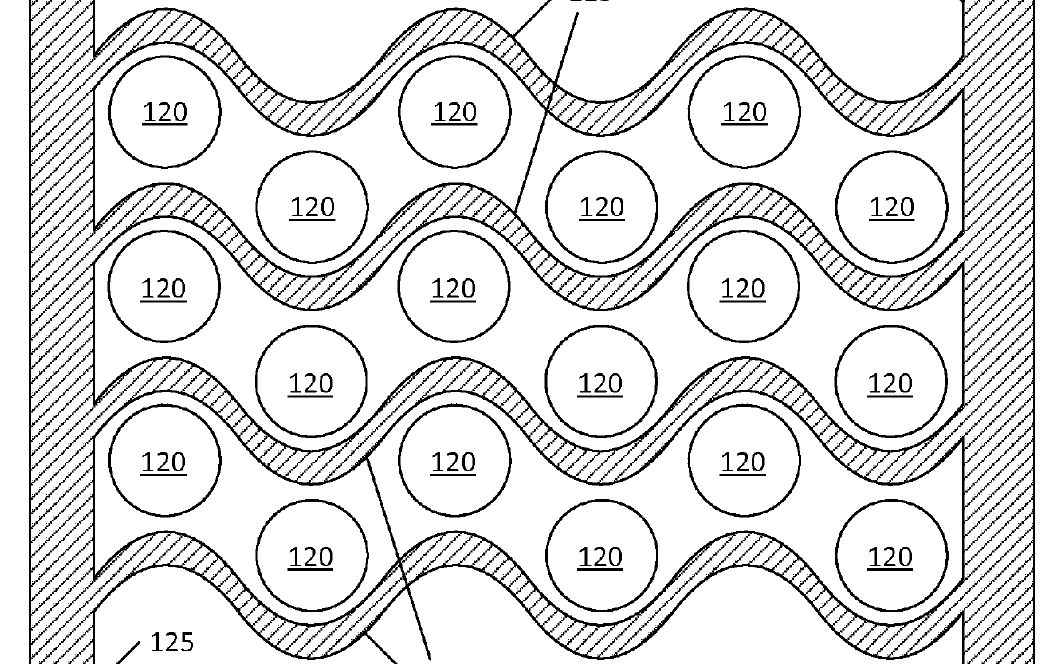
Judging from the actual disassembly diagram, there is a large cooling strip
between every two layers, probably mainly to save space and weight. The actual
arrangement and direction of the heat dissipation belts are not as regular as in
the schematic diagram of the patent, but in a ring shape.

The second is that Tesla adopts a method similar to the "two-way cooling"
mentioned above, that is, the direction of the left and right heat dissipation
channels is reversed, the left side flows from the bottom to the top, and the
right side flows from the top to the bottom to prevent the unbalanced
temperature between the upper and lower sides.
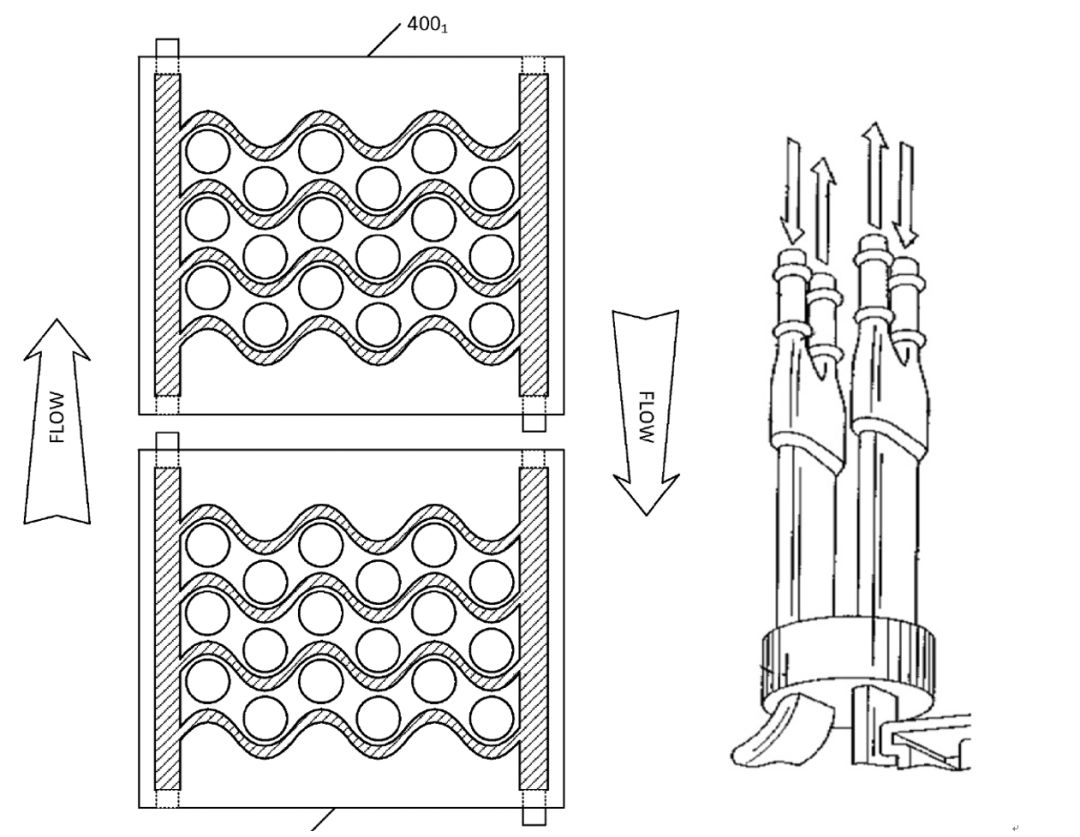
Judging from the actual dismantling pictures, it is true that each cooling
unit has four water pipe interfaces, two in and two out.
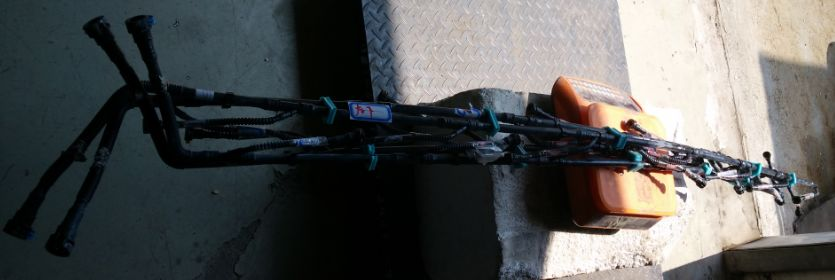
As can be seen from another picture, although the principle is very simple,
the winding and arrangement of the two opposite circuits is quite complicated.
The purpose of this is to ensure that the heat dissipation/heating of each cell
is relatively balanced.
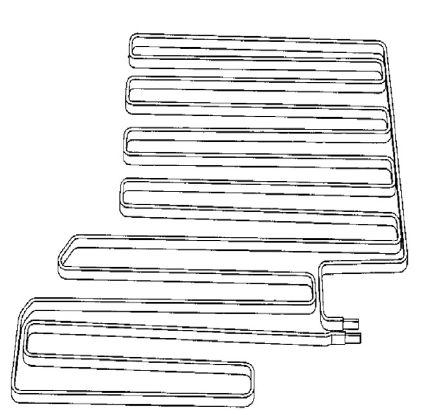
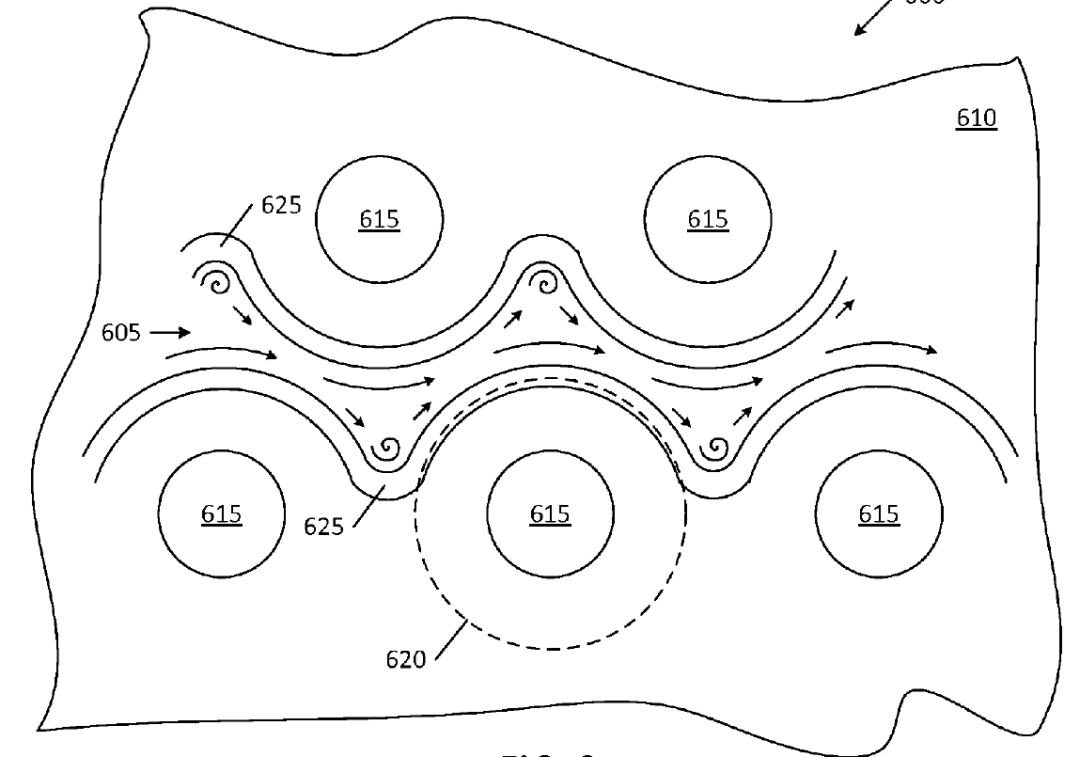
Universal Volt for d2 square cells
Compared with the aggressive Tesla, GM's Volt uses a more stable square
cell, but it also puts a lot of effort into thermal management.
Because the contact surface of the square cells is relatively large, GM
directly adds a heat dissipation ratchet between each two cells, and transfers
the heat to the cooling circuit below through the ratchet.
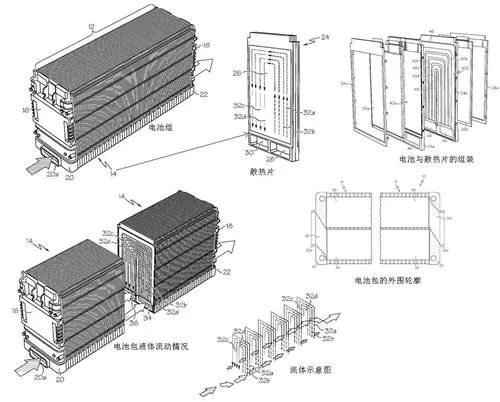
It may be due to the fact that the effect of the heat dissipation tabs is
larger than the serpentine contact surface of Tesla, and the thermal resistance
is smaller. GM did not design two-way flow to control the temperature
difference, which may not be as much as Volt's battery pack. body, the overall
balance is relatively good.
E: How to really do a good job in thermal management of lithium
batteries?
The first is to control the initial inconsistency of the cells
Before the cells are formed into a module, the voltage difference between
the cells is required to be less than 25mV and the voltage difference between
the modules is less than 30mV to ensure that the internal battery capacity of
the battery pack is balanced in the initial state.
The second is to have a deep thermal management theory and simulation
system
With the advancement of the times, the lithium battery systems of electric
vehicles and energy storage systems can be said to be larger and more complex,
and there are more and more factors affecting thermal management.
Therefore, there must be sufficient theoretical depth and an appropriate
simulation system. Only in this way can the initial design be completed
theoretically, and then the actual test can be carried out. In fact, there is no
absolutely correct theory and simulation system. The progress of theory and
simulation is based on basic knowledge and a large number of experimental
data.
The third is the need for enough experimental data
As mentioned in the previous point, without sufficient experimental data,
the correct theory and results will not be obtained. Of course, a large number
of experiments must be based on reasonable, scientific and accurate measurement
and simulation links.
This requires a lot of investment in R&D personnel, capital, and
equipment. SES Power believes that such investment is necessary and must be
effective.
The fourth is to use new technologies as much as possible
For example, an independent liquid cooling circuit is used to reduce the
influence of the motor and DCDC system operating conditions on the thermal
management of the battery. The aluminum water-cooling plate arranged at the
bottom of the battery module has high thermal conductivity and low flow
resistance, so as to achieve higher heat dissipation efficiency; while the
aluminum plate and the battery are covered with thermal grease (this is what DIY
computers dissipate heat from the CPU), improving the efficiency of heat
dissipation. The thermal conductivity between the cell and the heat dissipation
plate is improved, and the heat dissipation efficiency is improved, which is
more conducive to the control of the temperature consistency of the cell.
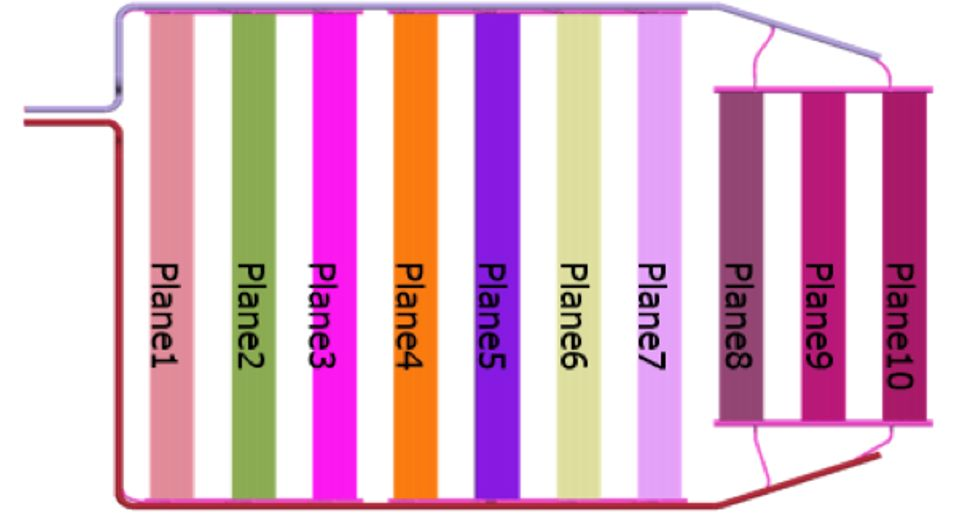
(Aluminum water cooling plates arranged in parallel)
In SES Power's point of view, thermal management of electric vehicles and
lithium battery energy storage systems is a very important part, but the two are
not exactly the same, because their uses, usage environments, requirements, etc.
are different. But in any case, there is only one purpose for effective thermal
management of lithium batteries, that is, to make lithium batteries work in a
comfortable state, so as to achieve the best performance ratio.


























